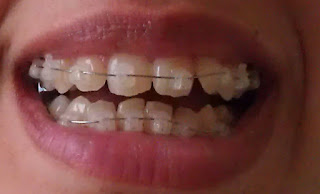How to get rid of gingivitis fast at home? Can you stop gingivitis? The brackets , wires, and bands of orthodontic treatment cover a large portion of the tooth surface and make it more difficult to properly clean your teeth.
One of the most common questions asked by patients is, ‘so how do you get rid of gingivitis with braces ? In this article I will therefore outline how you can keep your gums healthy whilst the teeth are getting shuffled around into perfection!
This is one reason that gingivitis is common with braces. So you have to take extra special care to achieve the oral hygiene that will keep gingivitis in check. At advanced stages, periodontal disease leads to falling out of teeth.
This condition is due to poor hygiene that causes the accumulation of bacteria. Insufficient teeth brushing or even flossing leads to accumulation of very harmful bacteria. Here are best techniques on how to cure gingivitis naturally at home. However, when we have a patient in braces , the ordinary method of flossing can be difficult, if not impossible, and much less effective.
Braces and Gingivitis can go together and therefore you must ensure that you brush at least twice a day without fail.

Every time that you eat something brush or at least rinse your mouth. The use of the right kind of toothbrush, toothpaste and flossing materials makes a big difference in helping you to do this. Brushing with braces and other orthodontic appliances can make it more challenging to clean your teeth. As a result, a buildup of an invisible, sticky film known as plaque can occur. If plaque is not removed daily by brushing and flossing, it produces bacteria that can cause a minor gum disease known as gingivitis.
Braces with Gingivitis If you already have gingivitis , all is not lost. Some patients can get orthodontic appliances on their teeth if they are starting to get their mild gum disease under control. However, Invisalign treatment may be a better option of you struggle with periodontitis and other gum problems.
Periodontal disease is an infection of the gums and the bone that support the teeth. A person having periodontitis will more than likely have significant gum recession and tooth mobility. This is the most serious stage of periodontal disease. The bottom line in treating and preventing gingivitis is that you have to eliminate as much plaque as you possibly can. Plaque, the sticky film containing bacteria that builds up on teeth and around the gum line, is the whole reason gingivitis happens.
Learn The Signs And Symptoms Of Unhealthy Gums. Learn Facts About The Difference Between Gingivitis And Periodontitis. How To Prevent This Gum Disease. Find Your Toothpaste Today!

Braces can make it more difficult to clean your teeth thoroughly while brushing and flossing. Anyone can develop gingivitis , not just those wearing braces. Gingivitis is the immune reaction of the gums to stop the bacterial infection from spreading.
In most cases, the gums of people wearing braces will already be inflamed. This would make it easier for bacteria to irritate and infect the gums. Use an antibacterial toothpaste. When it comes to brushing and flossing, braces can make it more difficult to clean your teeth thoroughly.
If plaque isn’t removed every day, it creates a sticky film that produces bacteria and can lead to gingivitis, a minor gum disease. One of the biggest learning curves can be finding and maintaining an effective dental hygiene routine. It can sometimes accompany orthodontic treatment, but fortunately, it’s reversible. That means there’s no need to wait until you’re finished with treatment to get rid of it!
Braces could make it harder to reach the debris with wiring and brackets in place. And , of course, when food becomes trapped in your gums, it could lead to buildup over time, resulting in gum inflammation. First, use a mouthwash that is a pre-rinse that will.
Does having periodontal disease mean I can’t or shouldn’t have braces to straighten my teeth? Orthodontics involves moving teeth through bone to relocate them in better places for both appearance and function. It is not recommended that a patient with ACTIVE gum disease get Invisalign or braces. However, a previous history of gum disease that is now stable, is not a contraindication for Invisalign.
This can cause increased bone loss around the teeth.
No comments:
Post a Comment
Note: Only a member of this blog may post a comment.